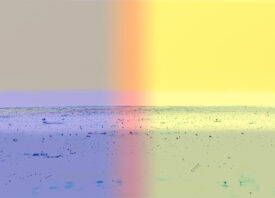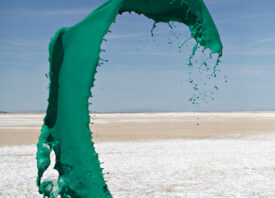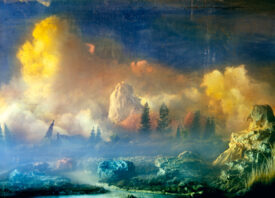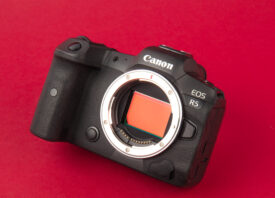Search this site
One Photographer’s Adventures to Some of the Most Stunning Places on Earth (Sponsored)

In many ways, the Welsh photographer Andy Lee reminds us of the great landscape artists of generations past. In an era in which wild landscapes face unprecedented dangers, he’s witnessed true marvels of the natural world–from a breathtaking lenticular cloudscape to a mind-blowing murder of crows in flight. Because of his background in painting and film, he understands the importance of taking his time, and he revels in the magical and serendipitous moments that happen when he least expects them. But while Lee’s work has deep roots in the history of fine art and the sublime landscape, he’s certainly a photographer of the modern age.
Whether he’s working abroad with charities or finding new ways to incorporate his twin passions for landscapes and portraits, Lee consistently finds fresh and novel ways to create meaningful images. And to showcase them in the most powerful way possible, he’s created a website and domain using Squarespace. With more than a few viral photos under his belt, Lee maintains a flourishing online presence and a gorgeous print shop that would give any physical gallery space a run for its money. In an era that seems defined by short attention spans and “the next big thing,” Lee proves once and for all that beautiful, well-made work will always leave a lasting impression. We interviewed him about his travels, the evolution of photography, and the importance of a timeless website design.
Why did you choose Squarespace as your website builder?
“My day job mostly consists of my role as a creative director in an advertising company. We work on many websites for a variety of different clients. When it came to designing one for myself, however, I initially hit a brick wall. I think many creatives feel this too. Maybe it’s because you are too close to the subject? Or maybe we’re just more motivated to produce the work and less to sell it.
“Squarespace made designing the site so much easier. I don’t have to worry about user experience and SEO, as this is already done for you with Squarespace. The templates themselves are beautifully designed, uncluttered, and minimal, and they allow artists to express themselves without having the interface get in the way of the work.”
What website template do you use?
“I currently use the template Jaunt, and before this, I used Avenue. What drew me to these templates, in particular, is the minimal feel and structure of the pages. I really like that there are many different ways to show the work within the galleries. I also love the simplicity of the interface.”

In what ways does your website complement and highlight your own personal aesthetic?
“My website compliments my aesthetic by making the content king. This, to me, is the most important thing about photography websites especially. Often, people try to be clever and add too much style over content, and the work gets lost. The user experience and journey should be unrestricted and put the work right up there as the hero.”
Your print store is stunning. What was it like setting that up?
“It was incredibly easy to set up the store on my site. Everything you need to sell your work immediately is included. I love the professional feel of it, and the interface and customer experience is up there with the best I’ve experienced.”

Your print store kind of resembles a real life gallery space, with beautiful sections for each series. Was this intentional?
“It was intentional. Often, I like to work in projects, be it subject matter or locations. This helps me feel like I’ve finished a piece of work or at least added a full stop for that moment in time. I have a decent social media following, and I like them to be able to find a specific subject or location easily without having to trawl through a long list of prints. Sectioning up the gallery and prints enables viewers to skip a particular section and just get straight to what they are interested in.”
How has shooting on film influenced your approach to photography in general?
“Shooting on film has influenced my approach to photography greatly. It’s not something you can necessarily do with haste; it teaches you to slow down and be more methodical when it comes to getting that shot. The physical and technical aspects of shooting large format film means that if you don’t take your time to get the right shot, you’re more likely to come back with nothing from the day. Even though I very much enjoy shooting digital also, this way of thinking and working bleeds into all aspects of my photography.”

Does your background in painting affect your work behind the camera as well?
“Photography, like any other art form, has the ability to move, engage, and inspire. My background in painting helps me understand light, shade, form, and composition. It also helps me appreciate a story and narrative, i.e. what you want to tell, how to take the viewer on a journey, and what you want them to know.”
Your Blue Iceland series went viral a few years back. What was that experience like?
“It was a blast. For a month or so, I was inundated with offers and interviews. It took me completely by surprise, to be honest. I wasn’t in any way prepared for the fuss that ensued. I’m not a huge social person. I don’t enjoy talking about myself, so it was kind of alien to me that people wanted to know about me.”
How do you think landscape photography as a genre has evolved in the digital age?
“All photography and almost all creative disciplines have changed substantially since the advent of the digital age. Primarily, digital makes things easier, which in itself is a joy. It strips bare the technical aspects of what once was a ‘dark art’ and puts technology into the hands of anyone with an idea or story to tell. This is revolutionary. Of course, this also has a downside with regards to the over-saturation of visual media. It is so much harder today to stand out and have your own voice.”
What’s the most unusual or memorable landscape you’ve photographed?
“Often, what makes something memorable to me is recording something you had no idea was going to happen at the time. These moments are few and far between. I’ve recently been shooting a lot of infrared, and this has increased my chances of getting these elusive shots.
“I had one memorable experience at Kirkjufell mountain in Iceland, a place I’ve wanted to visit for as long as I can remember. On arriving, the weather was so bad I couldn’t even see it in the fog and rain. For three days, I sat waiting for the cloud, sleet, and rain to disappear. I was just about to throw in the towel. As I packed the camper, the weather changed all of a sudden. There was a bright blast of sunlight, and there, in front of me, Kirkjufell mountain started to appear in all its glory.”
What about people? What has been your most powerful experience in portraiture?
“I’ve been lucky enough to travel extensively with work and have met with some fascinating people. As far as a powerful experience, I would have to say it’s the work I did for Orbis International, a flying eye hospital that trained local doctors and ophthalmologists in some of the most economically challenged countries on the planet. Nothing can prepare you for the emotion you feel when they take the bandages off a patient that was once blinded by a totally preventable illness in order for them to see once again. It was a truly humbling experience.”

You use film, digital, infrared…you name it. Why is it important to you to keep learning new techniques and mixing things up?
“This urge to mix things up has primarily come from my background in video and film. Taking photographs was a way of taking a break from filmmaking. I like to use any tool at my disposal, and each tool gives me something a little different. It’s no different from someone choosing a different colored pencil or paint. They are all just tools that enable me to leave a mark.”
Get started with your Squarespace website today and use the code FEATURESHOOT to get 10% off your first purchase.
Squarespace is a Feature Shoot sponsor.



